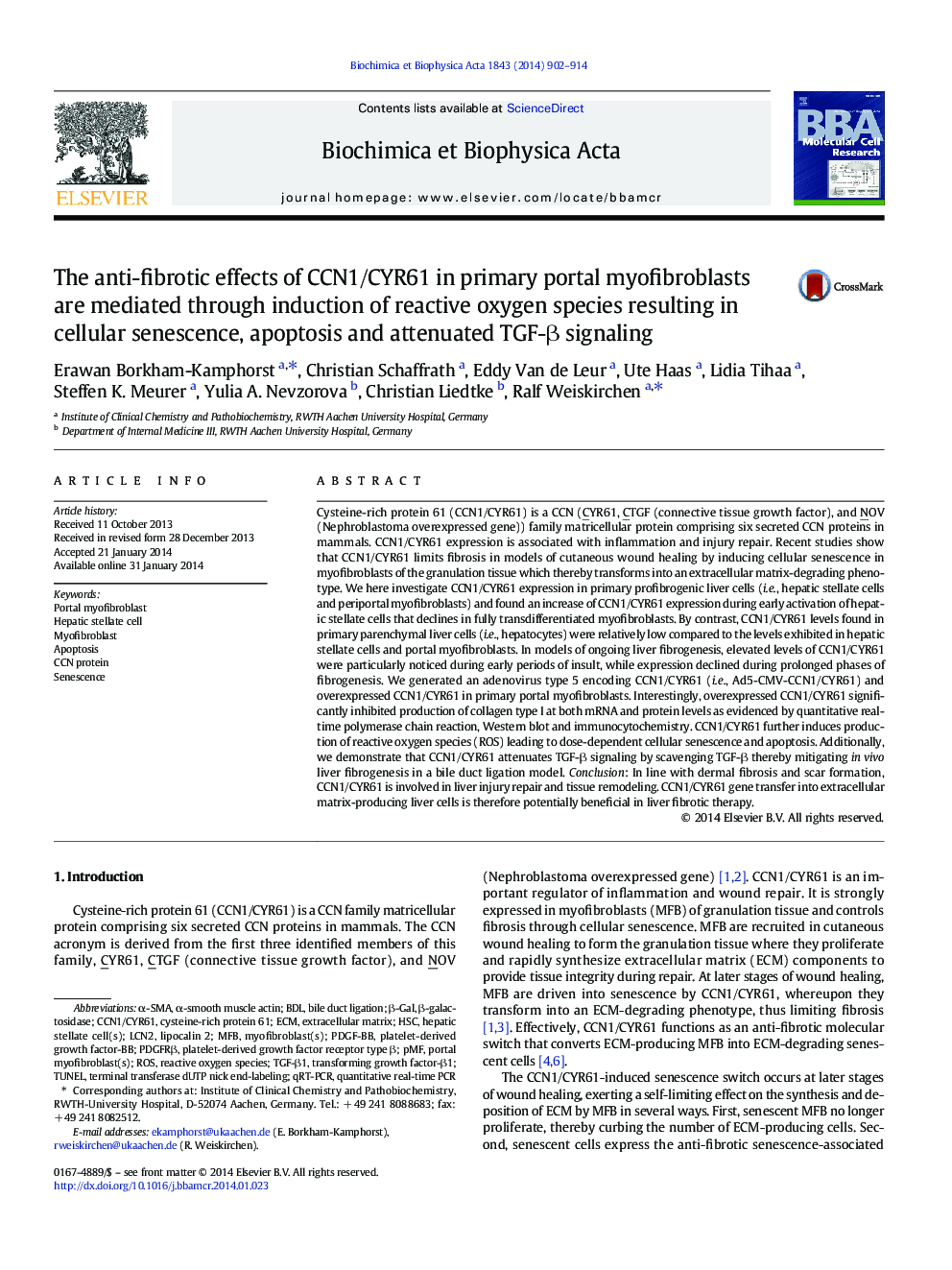| کد مقاله | کد نشریه | سال انتشار | مقاله انگلیسی | نسخه تمام متن |
|---|---|---|---|---|
| 1950600 | 1055671 | 2014 | 13 صفحه PDF | دانلود رایگان |

• CCN1/CYR61 induces cellular senescence and apoptosis in portal myofibroblasts and hepatic stellate cells.
• CCN1/CYR61 reduces expression of fibrotic marker genes in profibrogenic liver cells.
• CCN1/CYR61 promotes tissue remodeling and prevents liver fibrosis.
• CCN1/CYR61 induces cellular stress, Fas, p38 and JNK phosphorylation in portal myofibroblasts.
• CCN1/CYR61 controls reactive oxygen formation and TGF-β signaling.
Cysteine-rich protein 61 (CCN1/CYR61) is a CCN (CYR61, CTGF (connective tissue growth factor), and NOV (Nephroblastoma overexpressed gene)) family matricellular protein comprising six secreted CCN proteins in mammals. CCN1/CYR61 expression is associated with inflammation and injury repair. Recent studies show that CCN1/CYR61 limits fibrosis in models of cutaneous wound healing by inducing cellular senescence in myofibroblasts of the granulation tissue which thereby transforms into an extracellular matrix-degrading phenotype. We here investigate CCN1/CYR61 expression in primary profibrogenic liver cells (i.e., hepatic stellate cells and periportal myofibroblasts) and found an increase of CCN1/CYR61 expression during early activation of hepatic stellate cells that declines in fully transdifferentiated myofibroblasts. By contrast, CCN1/CYR61 levels found in primary parenchymal liver cells (i.e., hepatocytes) were relatively low compared to the levels exhibited in hepatic stellate cells and portal myofibroblasts. In models of ongoing liver fibrogenesis, elevated levels of CCN1/CYR61 were particularly noticed during early periods of insult, while expression declined during prolonged phases of fibrogenesis. We generated an adenovirus type 5 encoding CCN1/CYR61 (i.e., Ad5-CMV-CCN1/CYR61) and overexpressed CCN1/CYR61 in primary portal myofibroblasts. Interestingly, overexpressed CCN1/CYR61 significantly inhibited production of collagen type I at both mRNA and protein levels as evidenced by quantitative real-time polymerase chain reaction, Western blot and immunocytochemistry. CCN1/CYR61 further induces production of reactive oxygen species (ROS) leading to dose-dependent cellular senescence and apoptosis. Additionally, we demonstrate that CCN1/CYR61 attenuates TGF-β signaling by scavenging TGF-β thereby mitigating in vivo liver fibrogenesis in a bile duct ligation model. Conclusion: In line with dermal fibrosis and scar formation, CCN1/CYR61 is involved in liver injury repair and tissue remodeling. CCN1/CYR61 gene transfer into extracellular matrix-producing liver cells is therefore potentially beneficial in liver fibrotic therapy.
Journal: Biochimica et Biophysica Acta (BBA) - Molecular Cell Research - Volume 1843, Issue 5, May 2014, Pages 902–914